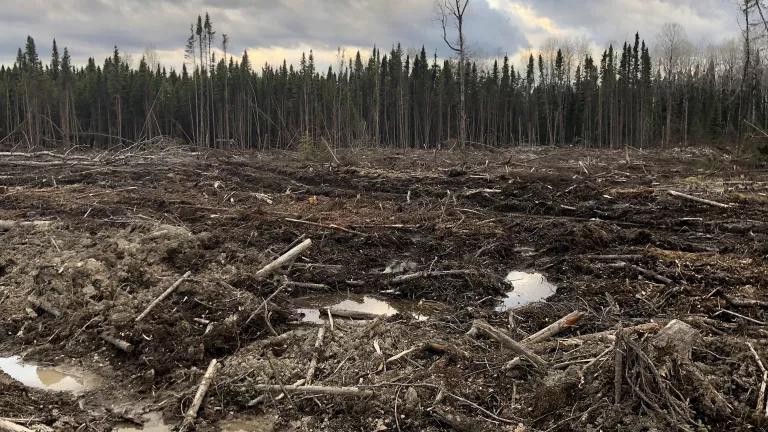Studies Expose Reality of Logging-Driven Forest Degradation in Canada
New publications on the impact of industrial logging in Canada reveal pervasive forest degradation and significant climate consequences,

Clearcut in Ontario
River Jordan for NRDC
Canada’s international reputation for forest sustainability has thrived on illusion, on manipulating perception so that impacts to the forest, no matter how profound, recede into mollifying mirage. 1.3 million acres of annual clearcuts are not deforested—they are simply forests in a different, maybe even soon to be better, form. The tens of millions of tonnes of carbon dioxide logging emits are hidden behind creative accounting. Indelible logging roads disappear in an array of blurry satellite pixels.
In 2024, science is overtaking artifice. A rapid succession of peer-reviewed studies and reports all point to a single unambiguous conclusion: that Canada’s unqualified claims of “sustainable forest management” belie a reality of widespread forest degradation.
Canada’s governments have insisted for years to global policymakers and companies that it is unnecessary to apply additional sustainability standards to its conscientiously managed forests. The heavy implication of their messaging is that, while countries like Brazil and Indonesia may need the Global North’s sturdy guidance and sound oversight, Canada rises above pedestrian concerns like deforestation and forest degradation. In fact, when policymakers in California and New York sought to include the boreal forest in bills that would ensure sustainable procurement of forest-risk commodities, the Canadian government, along with the governments of Ontario, Quebec, Alberta, and British Columbia, balked. Not only is there no deforestation, they insisted, but there is also no degradation— the erosion of ecological value—either.
This flew in the face of scientific evidence showing logging’s impacts on species, carbon storage, and other critical ecological functions. Now, a new peer-reviewed study from internationally renowned forest experts has left no ambiguity: Canada’s industrial logging has been degrading its forests.
Revealing Logging’s Cumulative Impact
The study, profiled in The New York Times, found that since 1976, logging spanned 35.4 million acres of boreal forest in Ontario and Quebec alone, fundamentally changing the health and integrity of the forest. According to their analysis, 19 of the 21 boreal caribou herds in the two provinces are at “high” or “very high” risk of disappearing. Even-aged management is eradicating older forests, leaving a greater proportion of younger stands. Ultimately, the study concluded, “Major changes are needed to boreal forest management in Ontario and Quebec for it to be ecologically sustainable for caribou populations but also for other elements of biodiversity associated with older forests and their attributes.”
As lead author Dr. Brendan Mackey summarized, “There has been a high level, ecologically speaking, of forest degradation.”

The orange patches show areas that have been logged in Ontario and Quebec since 1976. Turquoise indicates areas where the forest is at least 100 years old.
Griffith Climate Action Beacon, Griffith University
Exposing Carbon Accounting Loopholes
On the heels of that bombshell, Canadian scientists published a peer-reviewed paper affirming the Canadian Environment Commissioner’s report from last year urging Canada to address flaws and opacities in its forest carbon accounting. As the study showed, while Canada’s annual greenhouse gas inventory represents the forestry sector as roughly carbon neutral, between 2005-2021, logging directly resulted in an average of 91 megatonnes of carbon dioxide emissions annually. This makes logging one of the country’s highest-emitting industries, recently even outstripping the electricity and agriculture sectors.
The scientists traced the gaping discrepancy between Canada’s presentation of the sector and its actual footprint to an unbalanced methodology that essentially credits industry for carbon absorbed by forests it hasn’t cut. Instead, the study pieces together the elements that can be reasonably attributed to the logging industry: emissions from the logged forest, removals due to post-logging forest regrowth, and the carbon temporarily stored in longer-lived wood products. Once the industry’s free ride on nature’s carbon absorption is taken off the ledger, it leaves a very different picture of the logging’s climate footprint.

Countering Distorted Messaging
Leading NGOs working in Canada, including NRDC, Nature Canada, and the David Suzuki Foundation, also collaborated to take on the textual bedrock of the government’s mythmaking, The State of Canada’s Forests Annual Report. For years, this government-issued publication has encapsulated the most egregious forest sector myths, proselytizing a narrative of “sustainable forest management” for companies and policymakers around the world.
The NGOs countered the Annual Report’s industry-friendly account with an counter-publication, The State of Forests in Canada: Seeing Through the Spin, that identifies and addresses omissions and distortions in the government’s rendering. Bringing in the latest science showing the impact of industrial logging on biodiversity, the climate, and the erosion of high-integrity forests, as well as examples of the sector’s failure to guarantee Indigenous rights, the NGO report shows the reality of Canada’s palliated account.
Global Policy Implications
These studies and report have profound policy implications. During the 2023 international climate conference, 193 countries coalesced around the urgency of halting and reversing deforestation and forest degradation by 2030 to meeting global climate targets, building off the 2021 Glasgow Leaders’ Declaration on Forests and Land Use. Policymakers in the European Union and Colorado have also advanced marketplace standards limiting trade in commodities tied to forest degradation, and major investors leaders have been integrating language on degradation into their policies and calling on companies to address it in their supply chains.
While international scrutiny of northern forests may have atrophied from decades of disuse, the evidence of degradation is impossible to ignore. Policymakers and the marketplace need to follow the amassing scientific evidence as they deliver on their commitments, acting on scientific reality, not tricks of the eye and the pen.




